|
ARTICLES
China's Archaeological Oscars | China Heritage Quarterly
China's Archaeological Oscars: The Top Ten Discoveries of 2006
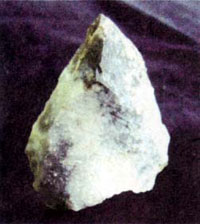
Fig.1
Pointed stone tool unearthed at the Dahe palaeolithic cave site in Yunnan province.
Source: Zhongguo wenwu bao (China Cultural Relics News), 11 April 2007, p.5.
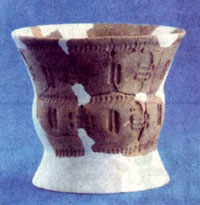
Fig.2
Beaker of white pottery (now discoloured) unearthed from the Xiantouling neolithic site in Shenzhen, Guangdong province.
Source: Zhongguo wenwu bao, 11 April 2007, p.5.
China's massive construction program over the past few years has seen a proliferation in the number of archaeological excavations that are necessitated by non-scientific excavations. It is difficult to keep abreast of the vast number of finds. Although it is not quite a red carpet event, the annual awards for the Top Ten Archaeological Discoveries of the previous year generate public interest in archaeology that professionals in many other countries would welcome. The State Administration of Cultural Heritage (SACH), as the former State Cultural Relics Bureau is now known, announced the top ten discoveries of 2006 in April 2007, and in the months since then a great deal of publicity has been given to these finds.
These ten significant finds were selected from 24 nominations in the annual competition held by the Chinese Society of Archaeology and the administration's newspaper China Cultural Relics News. A total of 46 archaeological institutes participated in the 24 short-listed excavations, because most excavations are joint undertakings by strong central- or provincial-level institutes and local teams often based in county-level museums. All archeological excavation and investigation projects in China over the previous year are eligible to be candidates for the preliminary selection of 24 excavations. The panel claims that, rather than being prompted by the 'treasure' principle, the selection was based on whether an excavation was properly conducted and scientific knowledge of the past was advanced.
The Top Ten Archaeological discoveries of 2006 were announced in Lanzhou, Gansu province, highlighting the fact that two of the major discoveries were in that province and demonstrating that the powerful hand of Beijing does not wish to be seen to be exercising cultural hegemony over regional archaeological bodies.
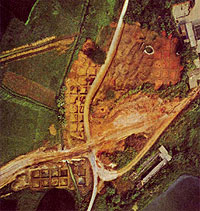
Fig.3
Aerial photograph of the Guye site under excavation.
Source: Zhongguo wenwu bao, 11 April 2007, p.5.
The long-standing rift between professional archaeologists and the bureaucrats of SACH inevitably resurfaces each year, and despite the brave face put on events, the Archaeology Institute of Chinese Academy of Social Sciences (CASS) has already initiated its own, rival system of evaluations. However, this year SACH strove to conduct lengthy meetings and briefings with archaeologists across China and a truce seems to have effected. This year the evaluation committee was dramatically expanded to 19 members, and secret ballot is now the order of the day, with an independent team counting the votes.
The finally selected top ten archaeological discoveries of 2006 ranged widely in date. Although the most recent excavation was of a site in Shanghai dating back to the Yuan dynasty (1271-1368), the earliest site, the Dahe cave site at Fuyuan in Yunnan province, was more than 30,000 years old.
The successful ten, which are by tradition arranged chronologically, were:
1. The Palaeolithic Cave Site at Dahe, Fuyuan County, Yunnan province. (Fig.1)
Excavating team: Yunnan Provincial Cultural Relics and Archaeology Institute.
Team leader: Ji Xueping.
The lowest layers of this palaeolithic cave site are dated to between 41,000 and 44,000 years BP. Since 2002, stone tools have been discovered here which were made using the Levallois technique of stone working. This provides evidence of cultural exchanges across the now largely discredited Movius Line that was once held to separate east and west. This interchange across Eurasia happened earlier in southern China than in the north. Archaeologists believe that the site provides evidence of the existence of more communication routes across Eurasia than pre-historians formerly believed.
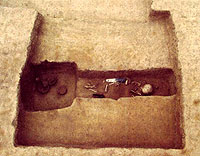 Fig.4
Grave at the mid Yangshao culture site at Xipo in Lingbao, Henan province.
Source: Zhongguo wenwu bao, 11 April 2007, p.5.
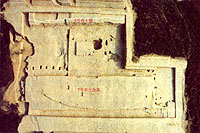 Fig.5
Aerial photograph of tamped earth areas at the Shang dynasty site at Gaohong in Shanxi province.
Source: Zhongguo wenwu bao, 11 April 2007, p.8.
2. Xiantouling neolithic site, Shenzhen, Guandong province. (Fig.2)
Excavating team: Shenzhen Municipal Cultural Relics and Archaeology Evaluation Institute and Shenzhen Municipal Museum.
Team leader: Li Hairong.
The remains at Xiantouling, which date back from 6,000 to 7,000 years, provide important criteria for archaeologists preparing a model of the stages of social development during this millennium in the Pearl River Delta. The finds also shed light on interpretative problems in Lingnan prehistoric culture, and archaeologists now posit the existence of the transitional Xiantouling culture named for this site.
3. Shell midden site at Guye in Gaoming, Guangdong province. (Fig.4)
Excavating team: Guangdong Provincial Cultural Relics and Archaeology Institute and Foshan City's Gaoming District Museum.
Team leader: Cui Yong.
This late neolithic site, dating back 4,500 years, is now regarded as China's best-preserved shell midden. It has provided archaeologists with valuable information on the diet of the neolithic inhabitants of the area and the various plants exploited as sources of food.
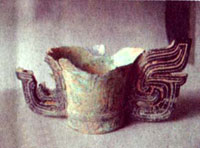 Fig.6
Bronze cup with winged handles unearthed from an earth tumulus grave in Pucheng, Fujian province.
Source: Zhongguo wenwu bao, 11 April 2007, p.8.
4. Neolithic cemetery at Xipo, Lingbao, Henan province. (Fig.3)
Excavating team: CASS Institute of Archaeology, Henan Provincial Cultural Relics and Archaeology Institute, Sanmenxia Municipal Archaeology Institute, Lingbao Municipal Cultural Relics Management Office.
Team leader: Chen Xingcan.
The excavation of these neolithic graves has advanced archaeologists' understanding of the society and economy of the Mid Yangshao culture (5,000-3,000 BCE). During the fifth and sixth excavation conducted in 2005 and 2006, 34 tombs were found with a large amount of funerary objects, including jade, pottery and bone items. The excavation represented the first discovery of graves of Mid Yangshao Culture in this area of Henan province.
5. The relics of Shang dynasty found at Gaohong, Liulin county, Shanxi province. (Fig.5)
Excavating team: Shanxi Provincial Archaeology Institute, Lüliang Municipal Cultural Relics Bureau, Liulin County Cultural Relics Management Office.
Team leader: Ma Sheng.
This is the first discovery of a late Shang dynasty (c.16th century-11th century BCE) bronze culture habitation site in the Lüliang Mountain region of Shanxi province, where 20 sites with tamped earth foundations were found. The discovery is of great value for the study of the unique Lüliang Mountain bronze culture. Late Shang bronzes had previously been discovered in the area, but all examples were found in graves. This excavation has made it clear that late Shang bronze culture had a local social base.
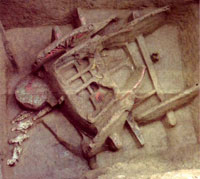 Fig.7
Photograph of an accompaniment burial of a horse-drawn chariot at the Majiayuan Warring States cemetery in Zhangjiachuan, Gansu province.
Source: Zhongguo wenwu bao, 11 April 2007, p.8.
 Fig.8
A view of the 'bronze musical instrument pit' at the Dabaozishan site in Lixian county, Gansu province.
Source: Zhongguo wenwu bao, 11 April 2007, p.8.
6. Tumulus tombs found in Guanjiu village, Pucheng county, Fujian province. (Fig.6)
Excavating teams: Fujian Museum; Fujian Minyue Royal City Museum.
Team leader: Yang Cong.
Tumulus tombs are considered to be characteristic of the Wuyue Culture of the Spring and Autumn (770-476 BCE) and Warring States (475-221 BCE) periods. These tumulus tombs found at Guanjiu, Pucheng, in 2006, were the first discovered in Fujian province. A total of 72 bronze funerary articles were excavated from the tombs, making the excavation the largest discovery of bronze items in Fujian's archaeological history.
7. Cemetery of the Warring States period found at Majiayuan, Zhangjiachuan county, Gansu province. (Fig.7)
Excavating team: Gansu Provincial Cultural Relics and Archaeology Institute and the Zhangjiachuan Huizu Autonomous County Museum.
Team leader: Wang Hui.
The value of excavating these tombs, which had been stripped by robbers, lies in their special structure and the five chariots found inside (four in the burial chambers and one in the tomb passageway). Such elaborately decorated chariots are very rare among Chinese archaeological discoveries.
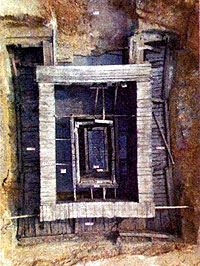 Fig.9
Aerial view of a Han tomb, showing the elaborate system of ticou timber construction that is a feature of Han dynasty tombs, at Lu'an in Anhui province.
Source: Zhongguo wenwu bao, 11 April 2007, p.8.
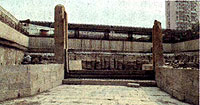 Fig.10
The partially restored Yuan dynasty sluice port unearthed in the Putuo district of Shanghai.
Source: Zhongguo wenwu bao, 11 April 2007, p.8.
8. The bronze musical instrument pit of the Qin dynasty found at the Dabaozishan site, Lixian county, Gansu province. (Fig.8)
Excavating teams: Gansu Provincial Cultural Relics and Archaeology Institute, Shaanxi Provincial Archaeology Institute, Peking University, North-western University and the National Museum.
Team leader: Zhao Huacheng.
The discovery of the musical instruments pit may help reveal the identity of the tomb's owner, believed to be one of the kings of the early Qin state, when the geographical centre of the Qin state was in Gansu province. The excavation also provides rare materials for researching the early history of China's ritual and music system, as well as the origins of the imperial system of sacrifices and the techniques of bronze casting of the early Qin state prior to the founding of the Qin dynasty (221-206 BCE).
9. The Shuangdun cemetery at Lu'an city, Anhui province. (Fig.9)
Excavating team: Anhui Provincial Cultural Relics and Archaeology Institute.
Team leader: Yang Lixin.
The discovery of this tomb of the Han dynasty (260 BCE-AD 220) and the royal cemetery of the Lu'an Kingdom sheds further light on the system of princely houses that extended across China in the Han dynasty.
10. The remains of a Yuan dynasty sluice gate at Zhidanyuan, Shanghai. (Fig.10)
Excavating team: Shanghai Museum.
Team leader: Song Jian.
The Zhidanyuan water gate, located in the Putuo district of Shanghai, has a history of 700 years. This hydraulic facility of the Yuan dynasty (1271-1368) is regarded as the finest example of such an ancient engineering project discovered in China to date.
|









